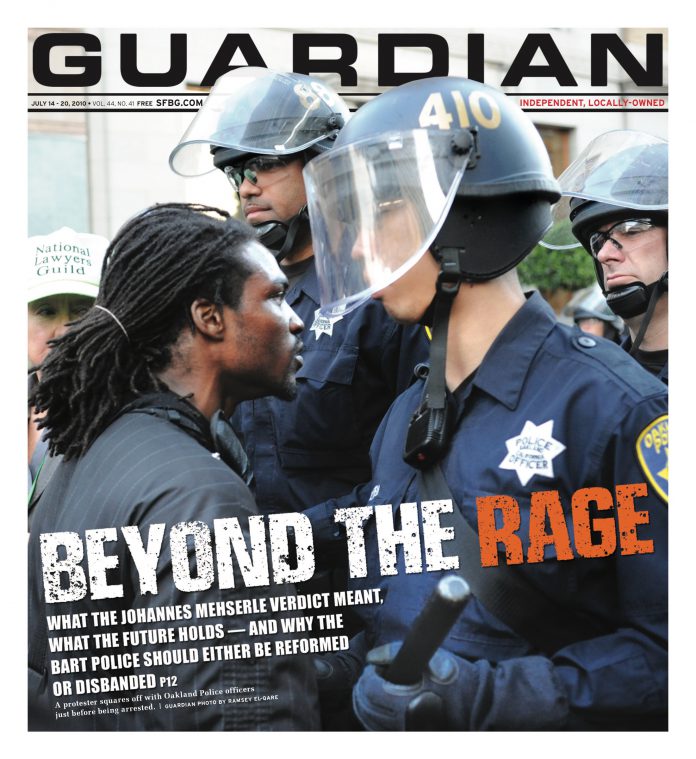DANCE/THEATER After rapidly selling out its two-week premiere in May 2009, the Joe Goode Performance Group returns to San Francisco’s lavish Old Mint for a luxurious one-month run of Traveling Light. JGPG’s haunted tour of SF’s oldest stone building, a monument to money power, unfolds as a series of made-up but history-laden vignettes scattered throughout the edifice, adding up to an inspired meditation on greed and desire, success and failure, the material and immaterial. On the eve of opening night, acclaimed Bay Area–based director-choreographer Joe Goode — who says the piece has changed only slightly since last year (“We’re filling up the space better and perhaps telling the story more clearly”) — spoke to SFBG from his East Bay home.
SFBG In addition to Traveling Light, you premiered another site-specific work last year, Fall Within, at the Ann Hamilton Tower in Geyserville. What’s the appeal with site-specific work? Do you approach such pieces very differently?
Joe Goode You have to in a way because there’s no front. People can see things from many different vantage points. Also some theatrical illusions are taken away from you. On the other hand, you have the personality, character, and history of the site, which is contributing enormous amounts of information to the moment. That is really exciting and delicious, and there’s a lot that you can do with it.
The way I work with performers—the way I elicit material from them so that it feels personal to them—[remains] similar. I’m interested in an intimate, close-up glimpse of a real human experience. Many site artists get involved with the contours of the architecture, the aural properties of the site. I’m interested in all that, too, but retain my interest in that personal narrative.
SFBG That personal aspect, though, intersects with the Mint , an edifice reverberating very strongly with a larger social crisis, namely the enormous, growing disparities in wealth.
JG That’s ultimately what the piece is all about. There’s a kind of grandeur to some of the interiors of the building, which is just a disgraceful, ostentatious display of wealth. You can’t help but feel it when you walk in there. This is the disparity that’s been present in this city since 1850! I tend to think of San Franciscans as this very egalitarian, alternative, radical, and thoughtful group of people, when in fact there’s an underpinning of those who have and those who don’t. Those who have make a lot of decisions about what happens in this city. Those who don’t, don’t have a voice particularly. [The Mint] reflects that for me.
SFBG How is that relation between social systems and personal narratives worked out in creating the performances?
JG A lot of it comes from my imagination. I spent a lot of time in those rooms. Some of the narratives don’t have anything particular to do with the history of the building, but there’s a gilded balcony or a particular corner that makes me think of a narrative—a particular time, a person, what they might have been going through. Then I begin to weave the characters, again working very intimately with the performers, asking them their stories and how they felt about this issue, what it brought to mind for them. And I go off and write it. That’s how it works.
SFBG You’ve used the term “felt performance” in referring to your work and your teaching method. Can you explain that term?
JG My theory is that I can’t make a resonant, rich, performative moment on onstage, or in a site, unless I’m having that experience. I can’t just package it. Really the job for the performer is constructing a road map, or an obstacle course even. You’re not working to create an experience for someone else; you’re working to create an experience for yourself. Human beings can share that. We have a very good authenticity meter in our hearts and minds. We [the audience] can get on the boat with you. But you have to be taking the ride as a performer; that’s what’s essential. If you’re not taking the ride, there’s no way we’re going to take it.
SFBG In your approach, dance-theater it’s sometimes called, you’ve been synthesizing forms, dialogue, movement, text, music, for over 30 years …
JG And I’m only 40! How does that work?
SFBG It’s a precocious body of work. But there must have been dance purists and theater purists who balked at the synthesis …
JG Well, there still are. Don’t suffer the illusion that those people have gone away. There are people who look at my work and say it’s not dance. There are certainly people who look at my work and say it’s not theater. It falls between the cracks; they’re unsettled by it and they don’t want any part of it. I think the contemporary viewer — I mean, we’re so much about the mashup; we’re so much about computer animation infiltrating live action. All these collisions are happening in media. For a younger audience to see dancers speak? They don’t care. “That’s cool, whatever, why wouldn’t they?” And that’s how I always felt.
There’s another element there too. When I started making this kind of work: I wanted to have some frank expression of myself as a gay man. Not in a silver jock strap waving a rainbow flag, but as a fully- dimensional human being. Not hiding that very essential part of my identity, but somehow bringing it in. I felt I needed my voice to do that. My body was going to get to an essential part of that, but there was another whole part that needed to be addressed. And pretty much from the beginning, there was a huge audience for it. I feel like I’ve definitely found my place with it. I don’t feel like there’s any going back, that’s for sure.

